Load Characteristics and Extreme Response of Straight-Bladed Floating VAWT Using a Fully Coupled Model
Abstract
1. Introduction
2. Numerical Methodology
2.1. Computational Fluid Dynamics
2.2. DFBI Superposition Motion
2.3. Mooring Model
2.4. Coupling Scheme of Aero-Hydrodynamics
3. Validation of Numerical Approach
3.1. Aerodynamic Validation
3.2. Hydrodynamic Validation
4. Model Description
4.1. OF-VAWT System
4.2. Wind Turbine
4.3. Floating Foundation
4.4. Numerical Model of OF-VAWT
4.4.1. Computational Domain
4.4.2. Strategy and Convergence of Mesh
4.4.3. Simulation Case
5. Time-Domain Analysis
6. Discussion
7. Conclusions
- The aerodynamic bending moment is always dominant in a total bending moment, and the aerodynamic torque induced by rotor resistance in extreme environments is significant. These results indicate that OF-VAWT has the requirement for a control module adjusting the pitch angle under extreme cases to reduce aerodynamic loads although VAWT has the ability to harness the energy in each direction without steering.
- In a wind-wave environment, the trend of power coefficient is opposite to motion. The performance variation is different in each case, quantitative analysis indicates the performance of OF-VAWT is more susceptible to wind compared to waves.
- In extreme environments, the power coefficient generated by rotors is unacceptable under a violent motion, nearly a quarter of the normal. In addition, there is severe green water induced by violent motion in enormous waves, and even the deck is almost submerged in the worst condition.
Author Contributions
Funding
Institutional Review Board Statement
Informed Consent Statement
Data Availability Statement
Conflicts of Interest
References
- Kaldellis, J.K.; Apostolou, D.; Kapsali, M.; Kondili, E. Environmental and social footprint of offshore wind energy. comparison with onshore counterpart. Renew. Energy 2016, 92, 543. [Google Scholar] [CrossRef]
- Ismail, M.F.; Vijayaraghavan, K. The effects of aerofoil profile modification on a vertical axis wind turbine performance. Energy 2015, 80, 20–31. [Google Scholar] [CrossRef]
- Borg, M.; Collu, M.; Kolios, A. Offshore floating vertical axis wind turbines, dynamics modelling state of the art. part ii: Mooring line and structural dynamics. Renew. Sustain. Energy Rev. 2014, 39, 1226–1234. [Google Scholar] [CrossRef]
- Rosenthal, W.; Lehner, S. Rogue waves: Results of the maxwave project. J. Offshore Mech. Arct. Eng. 2008, 130, 21006. [Google Scholar] [CrossRef]
- Chou, J.S.; Chiu, C.K.; Huang, I.K.; Chi, K.N. Failure analysis of wind turbine blade under critical wind loads. Eng. Fail. Anal. 2013, 27, 99–118. [Google Scholar] [CrossRef]
- Zhang, X.; Wang, M.; Wang, Y.; Liu, Y. Research on Failure of Offshore Wind Turbine Tower in Typhoon. In Proceedings of the 2018 OCEANS-MTS/IEEE Kobe Techno-Oceans (OTO), Kobe, Japan, 28–31 May 2018. [Google Scholar]
- Lechuga, A. Were freak waves involved in the sinking of the tanker”prestige”? Nat. Hazards Earth Syst. Sci. 2006, 6, 973–978. [Google Scholar] [CrossRef]
- Su, J.; Li, Y.; Chen, Y.; Han, Z.; Zhou, D.; Zhao, Y.; Bao, Y. Aerodynamic performance assessment of φ-type vertical axis wind turbine under pitch motion. Energy 2021, 225, 1. [Google Scholar] [CrossRef]
- Lei, H.; Zhou, D.; Bao, Y.; Chen, C.; Ma, N.; Han, Z. Numerical simulations of the unsteady aerodynamics of a floating vertical axis wind turbine in surge motion. Energy 2017, 127, 1. [Google Scholar] [CrossRef]
- Lei, H.; Zhou, D.; Lu, J.; Chen, C.; Han, Z.; Bao, Y. The impact of pitch motion of a platform on the aerodynamic performance of a floating vertical axis wind turbine. Energy 2017, 119, 369. [Google Scholar] [CrossRef]
- Wu, J.; Meng, L.; Zhao, Y.; He, Y. Coupled aerodynamic and hydrodynamic analysis of floating offshore wind turbine using cfd method. Trans. Nanjing Univ. Aeronaut. Astronaut. 2016, 33, 80–87. [Google Scholar]
- Tran, T.T.; Kim, D.H. A cfd study of coupled aerodynamic-hydrodynamic loads on a semisubmersible floating offshore wind turbine. Wind Energy 2018, 21, 70–85. [Google Scholar] [CrossRef]
- Wang, H.; Hu, Z.Q.; Meng, X.Y. Dynamic performance investigation of a spar-type floating wind turbine under different sea conditions. China Ocean Eng. 2018, 32, 256–265. [Google Scholar] [CrossRef]
- Zhang, Y.; Kim, B. A fully coupled computational fluid dynamics method for analysis of semi-submersible floating offshore wind turbines under wind-wave excitation conditions based on oc5 data. Appl. Sci. 2018, 8, 2314. [Google Scholar] [CrossRef]
- Guo, Y.; Liu, L.Q.; Li, Y.; Xiao, C.S.; Tang, Y.G. The surge-heavepitch coupling motions of the ϕ-type vertical axis wind turbine supported by the truss spar floating foundation. J. Hydrodyn. 2019, 31, 669–681. [Google Scholar] [CrossRef]
- Cheng, P.; Huang, Y.; Wan, D. A numerical model for fully coupled aero-hydrodynamic analysis of floating offshore wind turbine. Ocean Eng. 2019, 173, 183–196. [Google Scholar] [CrossRef]
- Li, X.; Zhu, C.; Fan, Z.; Chen, X.; Tan, J. Effects of the yaw error and the wind-wave misalignment on the dynamic characteristics of the floating offshore wind turbine. Ocean Eng. 2020, 199, 106960. [Google Scholar] [CrossRef]
- Gao, J.; Griffith, D.T.; Sakib, M.S.; Boo, S.Y. A semi-coupled aeroservo-hydro numerical model for floating vertical axis wind turbines operating on tlps. Renew. Energy 2022, 181, 692–713. [Google Scholar] [CrossRef]
- Lee, H.; Poguluri, S.K.; Bae, Y.H. Development and verification of a dynamic analysis model for floating offshore contra-rotating vertical axis wind turbine. Energy 2022, 240, 122492. [Google Scholar] [CrossRef]
- Borg, M.; Shires, A.; Collu, M. Offshore floating vertical axis wind turbines, dynamics modelling state of the art. part i: Aerodynamics. Renew. Sustain. Energy Rev. 2014, 39, 1214–1225. [Google Scholar] [CrossRef]
- Liu, L.; Guo, Y.; Zhao, H.; Tang, Y. Motions of a 5 mw floating vawt evaluated by numerical simulations and model tests. Ocean Eng. 2017, 144, 21–34. [Google Scholar] [CrossRef]
- Wang, K.; Hansen, M.O.L.; Moan, T. Dynamic analysis of a floating vertical axis wind turbine under emergency shutdown using hydrodynamic brake. Energy Procedia 2014, 53, 56–69. [Google Scholar] [CrossRef]
- Vita, L. Offshore Floating Vertical Axis Wind Turbines with Rotating Platform. Ph.D. Thesis, Technical University of Denmark (DTU), Denmark, 2011. [Google Scholar]
- Jin, X.; Zhao, G.; Gao, K.; Ju, W. Darrieus vertical axis wind turbine: Basic research methods. Renew. Sustain. Energy Rev. 2015, 42, 212–225. [Google Scholar] [CrossRef]
- Bianchini, A.; Balduzzi, F.; Ferrara, G.; Ferrari, L.; Persico, G.; Dossena, V.; Battisti, L. Detailed analysis of the wake structure of a straight blade h-darrieus wind turbine by means of wind tunnel experiments and computational fluid dynamics simulations. J. Eng. Gas Turbines Power 2018, 140, 32604. [Google Scholar] [CrossRef]
- Maeda, T.; Kamada, Y.; Murata, J.; Furukawa, K.; Yamamoto, M. Effect of number of blades on aerodynamic forces on a straight-bladed vertical axis wind turbine. Energy 2015, 90, 784. [Google Scholar]
- Coulling, A.J.; Goupee, A.J.; Robertson, A.N.; Jonkman, J.M.; Dagher, H.J. Validation of a fast semi-submersible floating wind turbine numerical model with deepcwind test data. J. Renew. Sustain. Energy 2013, 5, 23116. [Google Scholar] [CrossRef]
- Tran, T.T.; Kim, D.H. The coupled dynamic response computation for a semi-submersible platform of floating offshore wind turbine. J. Wind Eng. Ind. Aerodyn. 2015, 147, 104–119. [Google Scholar] [CrossRef]
- Luan, C.; Gao, Z.; Moan, T. Modelling and Analysis of a Semi-Submersible Wind Turbine with a Central Tower with Emphasis on the Brace System. In Proceedings of the Asme International Conference on Ocean, Nantes, France, 9–14 June 2013. [Google Scholar]
- Tran, T.T.; Kim, D.H. A cfd study into the influence of unsteady aerodynamic interference on wind turbine surge motion. Renew. Energy 2016, 90, 204–228. [Google Scholar] [CrossRef]
- Mohammadi, E.; Fadaeinedjad, R.; Naji, H.R. Using a new wind turbine emulator to analyze tower shadow and yaw error effects. Energy Convers. Manag. 2018, 174, 378–387. [Google Scholar] [CrossRef]
- Huang, Y.; Cheng, P.; Wan, D. Numerical analysis of a floating offshore wind turbine by coupled aero-hydrodynamic simulation. J. Mar. Sci. Appl. 2019, 18, 82. [Google Scholar] [CrossRef]
- Borg, M.; Collu, M. A comparison between the dynamics of horizontal and vertical axis offshore floating wind turbines. Philos. Trans. R. Soc. A: Math. Phys. Eng. Sci. 2015, 373, 20140. [Google Scholar] [CrossRef]
- Fang, Y.; Duan, L.; Han, Z.; Zhao, Y.; Yang, H. Numerical analysis of aerodynamic performance of a floating offshore wind turbine under pitch motion. Energy 2020, 192, 116. [Google Scholar] [CrossRef]
- Farrugia, R.; Sant, T.; Micallef, D. A study on the aerodynamics of a floating wind turbine rotor. Renew. Energy 2016, 86, 770–784. [Google Scholar] [CrossRef]
- Cheng, Z.; Madsen, H.A.; Gao, Z.; Moan, T. A fully coupled method for numerical modeling and dynamic analysis of floating vertical axis wind turbines. Renew. Energy 2017, 107, 604. [Google Scholar] [CrossRef]
- Collu, M.; Borg, M.; Shires, A.; Brennan, F.P. FloVAWT: Progress on the development of a coupled model of dynamics for floating offshore vertical axis wind turbines. In Proceedings of the International Conference on Offshore Mechanics and Arctic Engineering, American Society of Mechanical Engineers, Nantes, France, 9–14 June 2013; p. V008T09A045. [Google Scholar]
- Larsen, T.J.; Madsen, H.A. On the way to reliable aeroelastic load simulation on vawts. Proc. EWEA 2013, 9, 2013. [Google Scholar]
- Cheng, Z.; Wang, K.; Gao, Z.; Moan, T. A comparative study on dynamic responses of spar-type floating horizontal and vertical axis wind turbines. Wind Energy 2017, 20, 305–323. [Google Scholar] [CrossRef]
- Cheng, Z.; Wang, K.; Gao, Z.; Moan, T. Dynamic response analysis of three floating wind turbine concepts with a two-bladed Darrieus rotor. J. Ocean Wind Energy 2015, 2, 213–222. [Google Scholar] [CrossRef]
- Hansen, J.T.; Mahak, M.; Tzanakis, I. Numerical modelling and optimization of vertical axis wind turbine pairs: A scale up approach. Renew. Energy 2021, 171, 1371–1381. [Google Scholar] [CrossRef]
- Bangga, G.; Hutomo, G.; Wiranegara, R.; Sasongko, H. Numerical study on a single bladed vertical axis wind turbine under dynamic stall. J. Mech. Sci. Technol. 2017, 31, 261–267. [Google Scholar] [CrossRef]
- Bangga, G.; Hutani, S.; Heramarwan, H. The Effects of Airfoil Thickness on Dynamic Stall Characteristics of High-Solidity Vertical Axis Wind Turbines. Adv. Theory Simul. 2021, 4, 2000204. [Google Scholar] [CrossRef]
- Ferreira, C.S.; Bijl, H.; Van Bussel, G.; Van Kuik, G. Simulating dynamic stall in a 2D VAWT: Modeling strategy, verification and validation with particle image velocimetry data. J. Phys. Conf. Ser. 2007, 75, 012023. [Google Scholar] [CrossRef]
- Buchner, A.J.; Soria, J.; Honnery, D.; Smits, A.J. Dynamic stall in vertical axis wind turbines: Scaling and topological considerations. J. Fluid Mech. 2018, 841, 746–766. [Google Scholar] [CrossRef]
- Bianchini, A.; Bangga, G.; Baring-Gould, I.; Croce, A.; Cruz, J.I.; Damiani, R.; Erfort, G.; Simao Ferreira, C.; Infield, D.; Nayeri, C.N.; et al. Current status and grand challenges for small wind turbine technology. Wind Energy Sci. 2022, 7, 2003–2037. [Google Scholar] [CrossRef]
- Bangga, G.; Dessoky, A.; Lutz, T.; Krämer, E. Improved double-multiple-streamtube approach for H-Darrieus vertical axis wind turbine computations. Energy 2019, 182, 673–688. [Google Scholar] [CrossRef]
- Paraschivoiu, I. Double-multiple streamtube model for studying vertical-axis wind turbines. J. Propuls. Power 1988, 4, 370–377. [Google Scholar] [CrossRef]
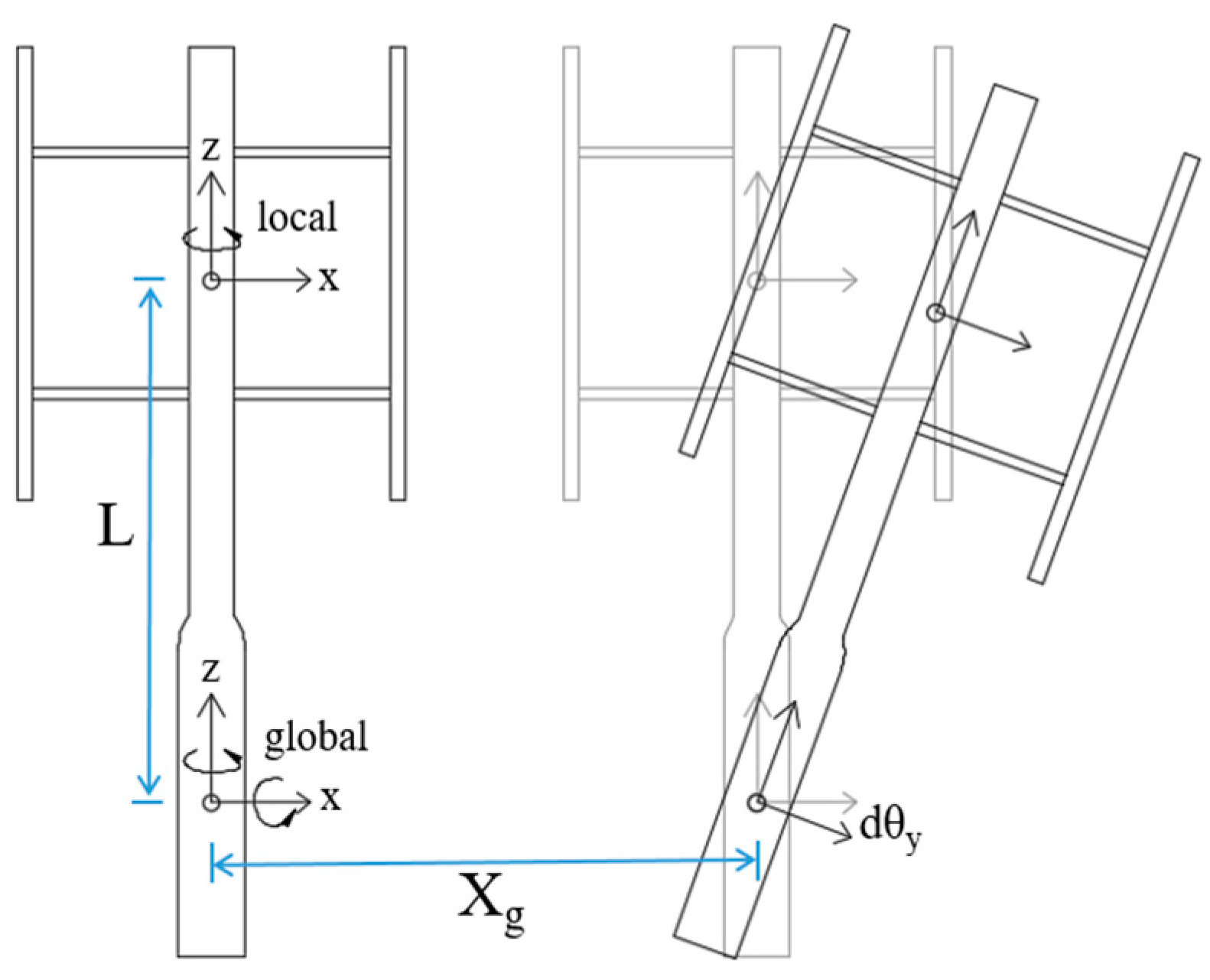
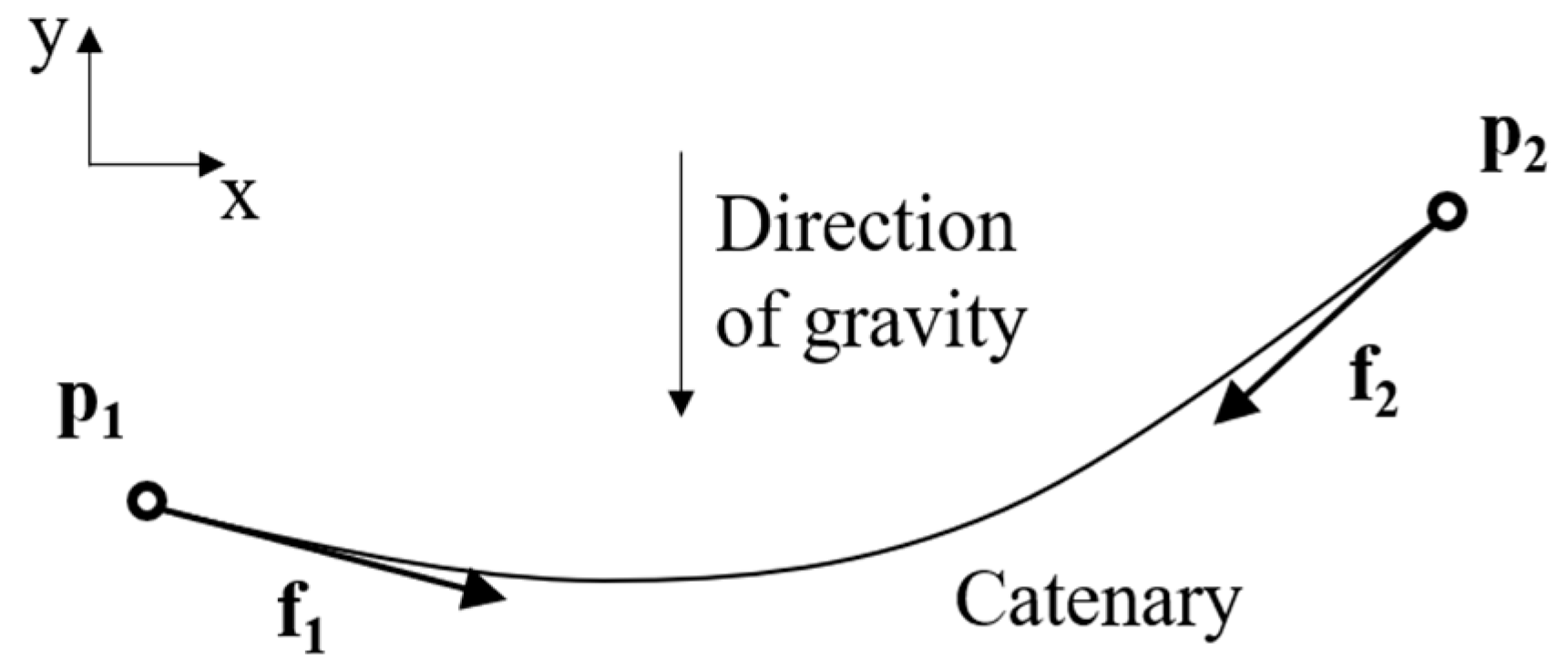

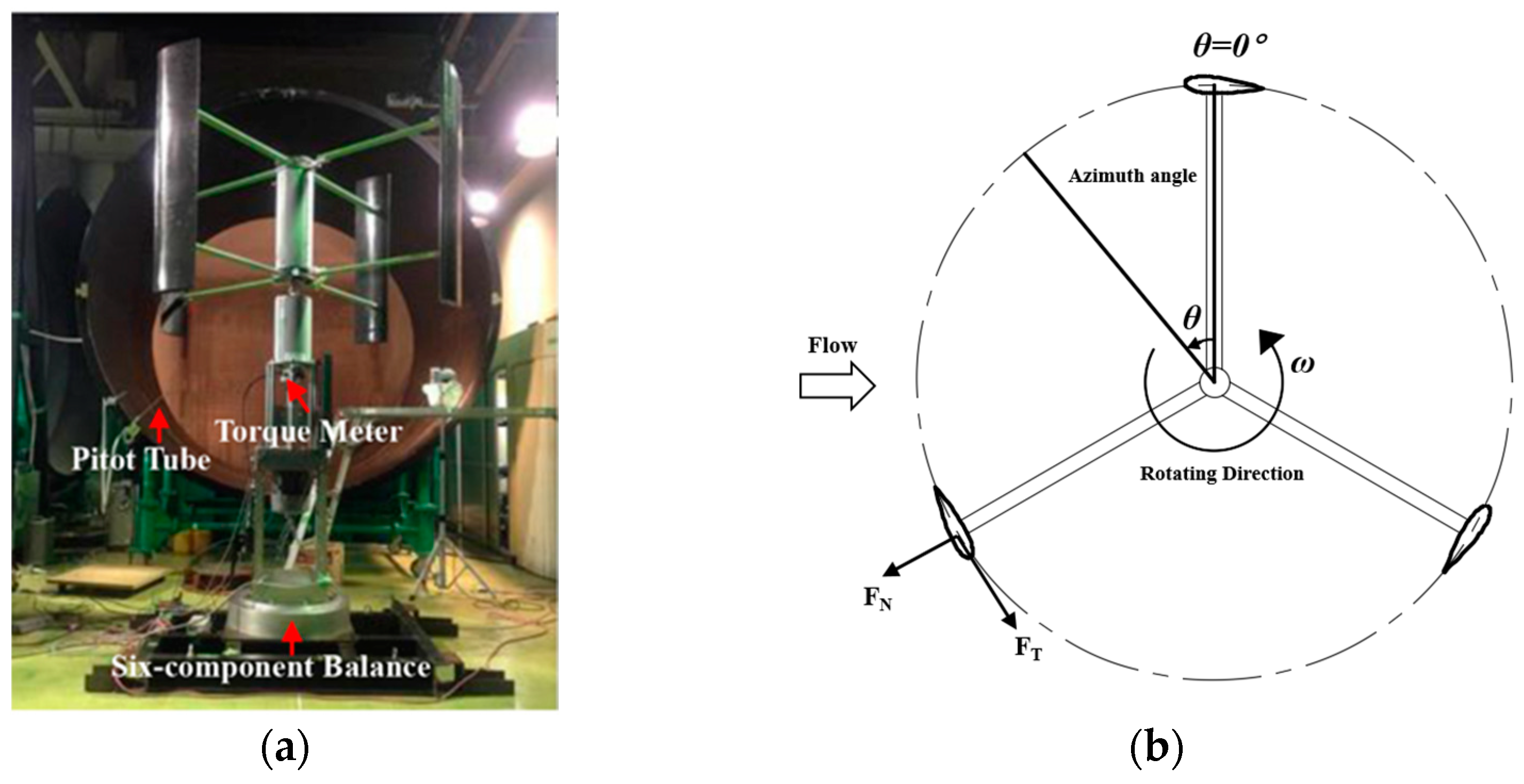
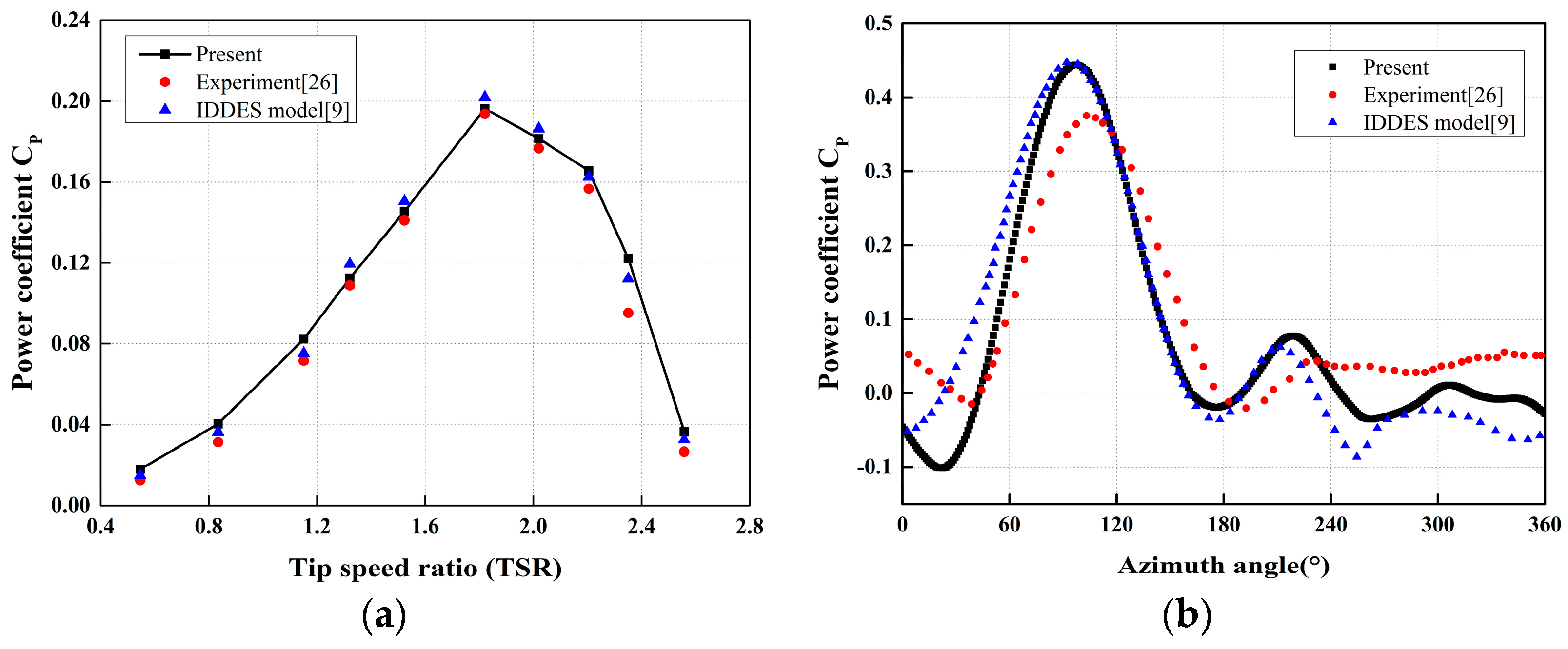
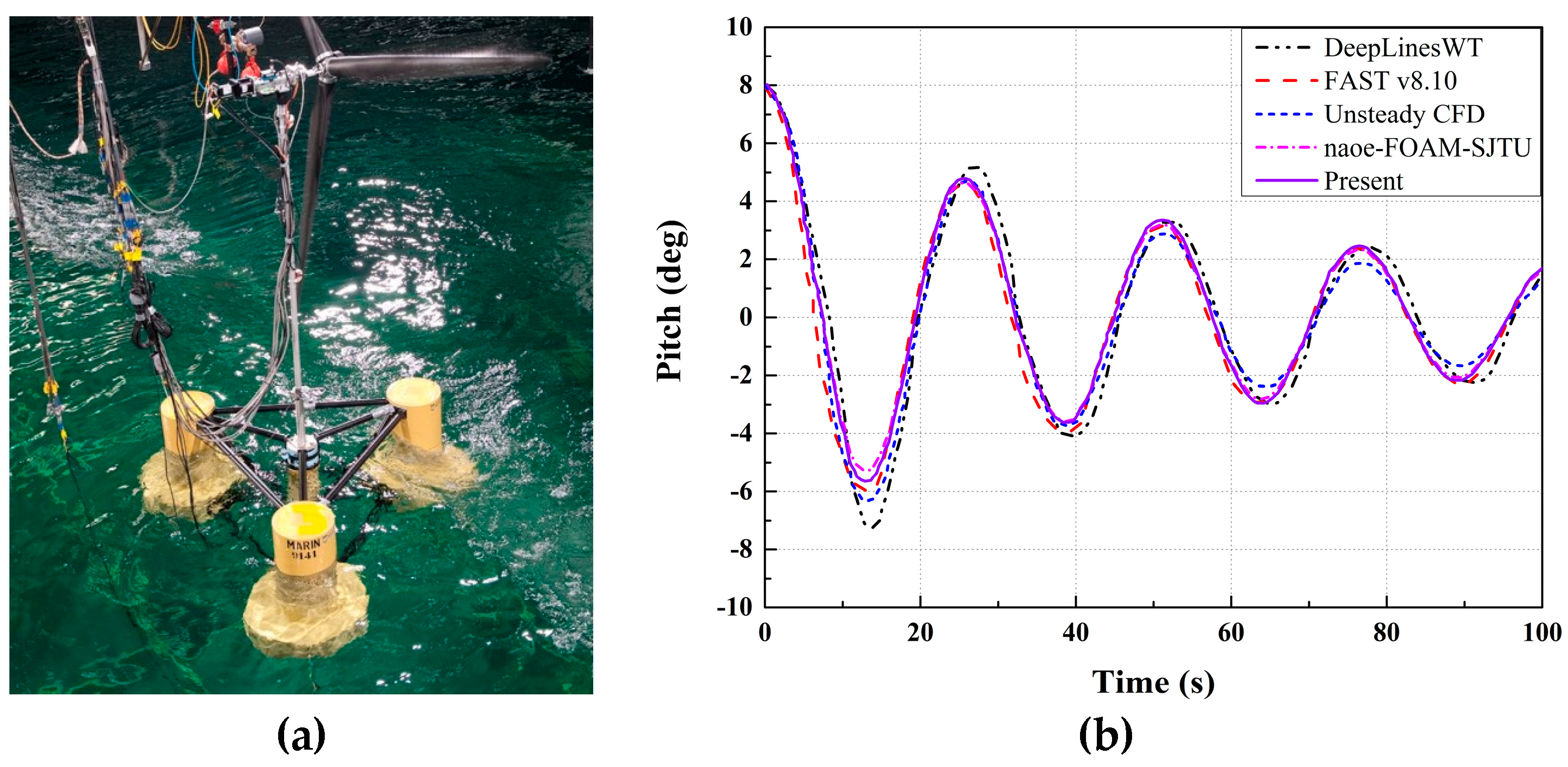
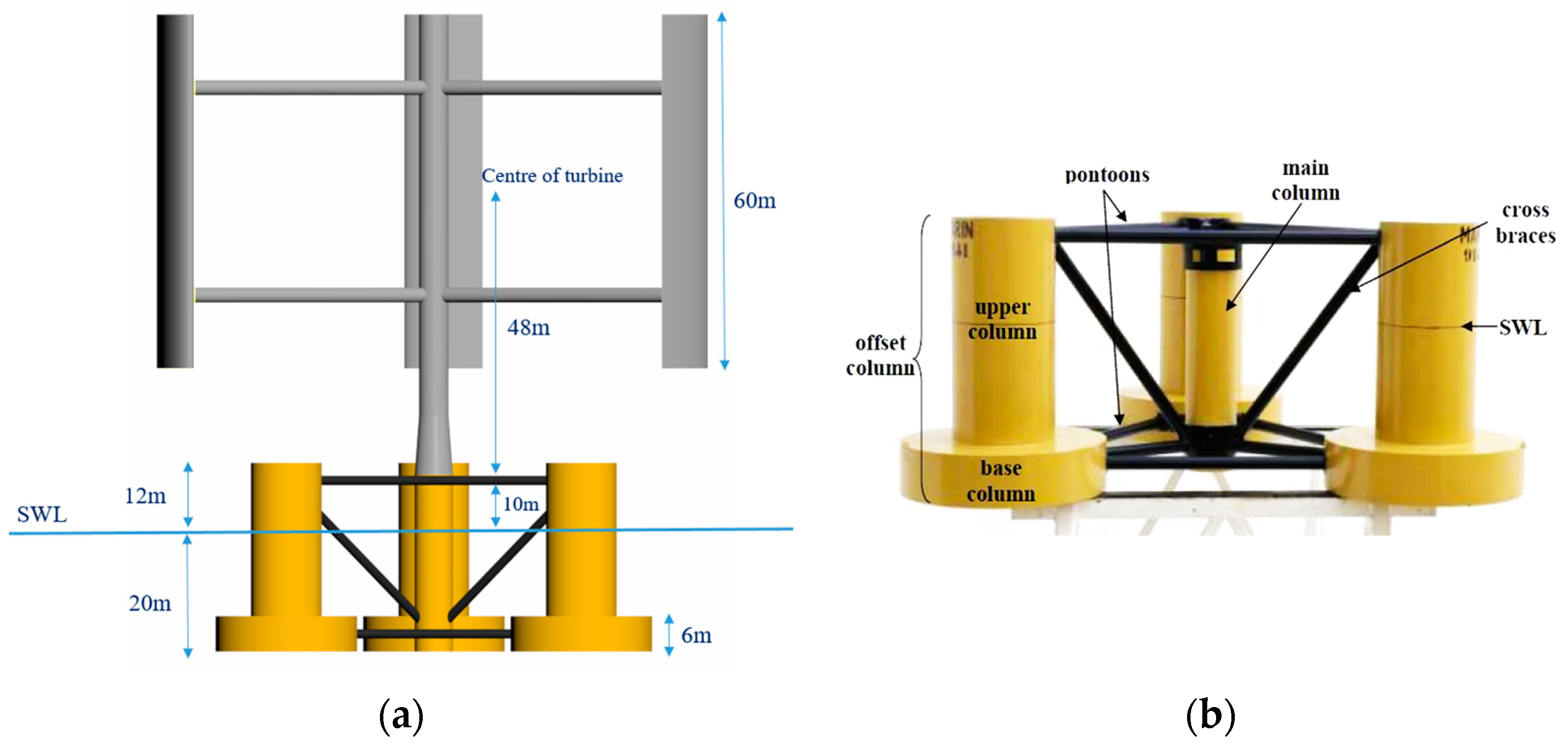

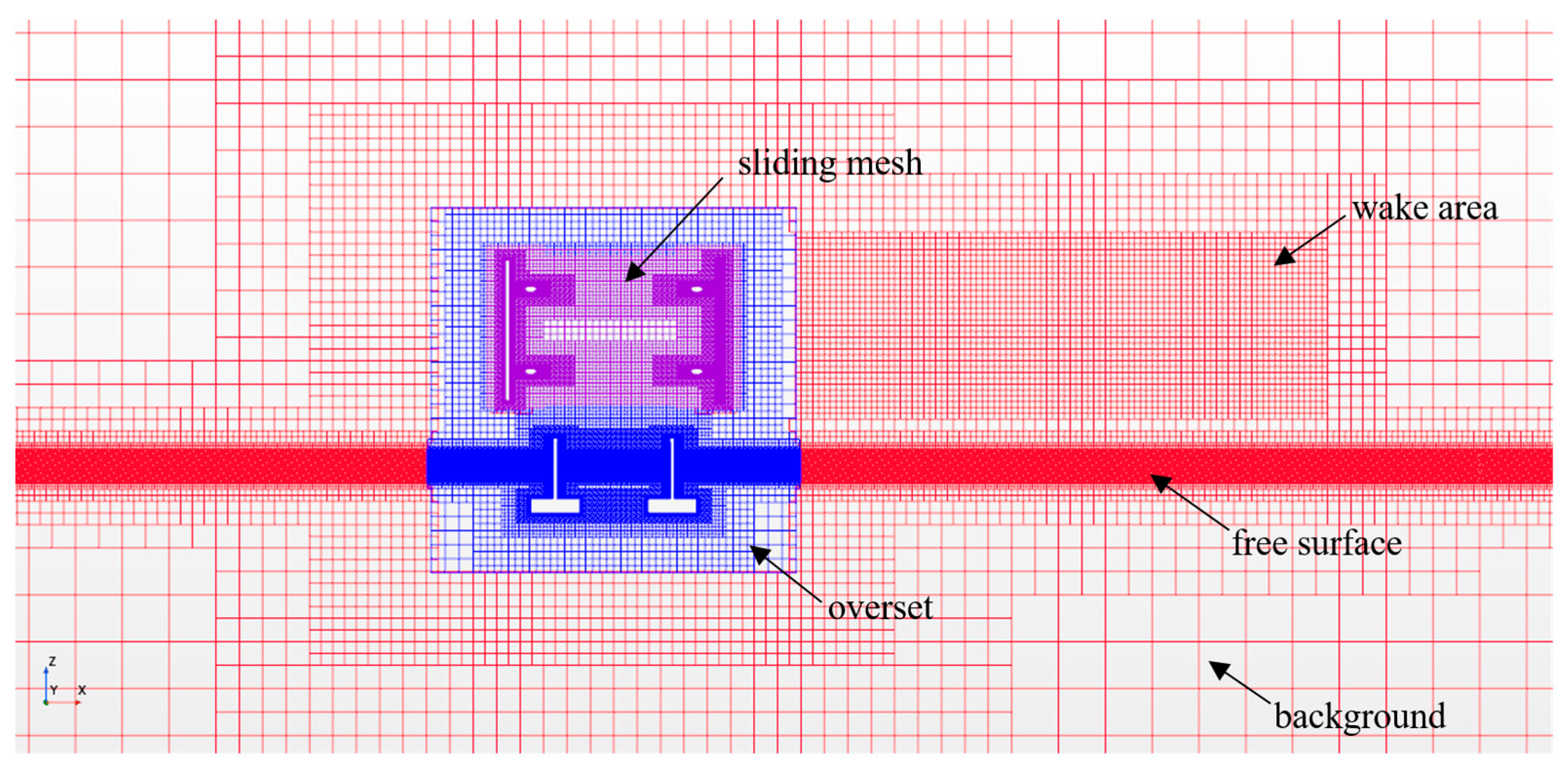

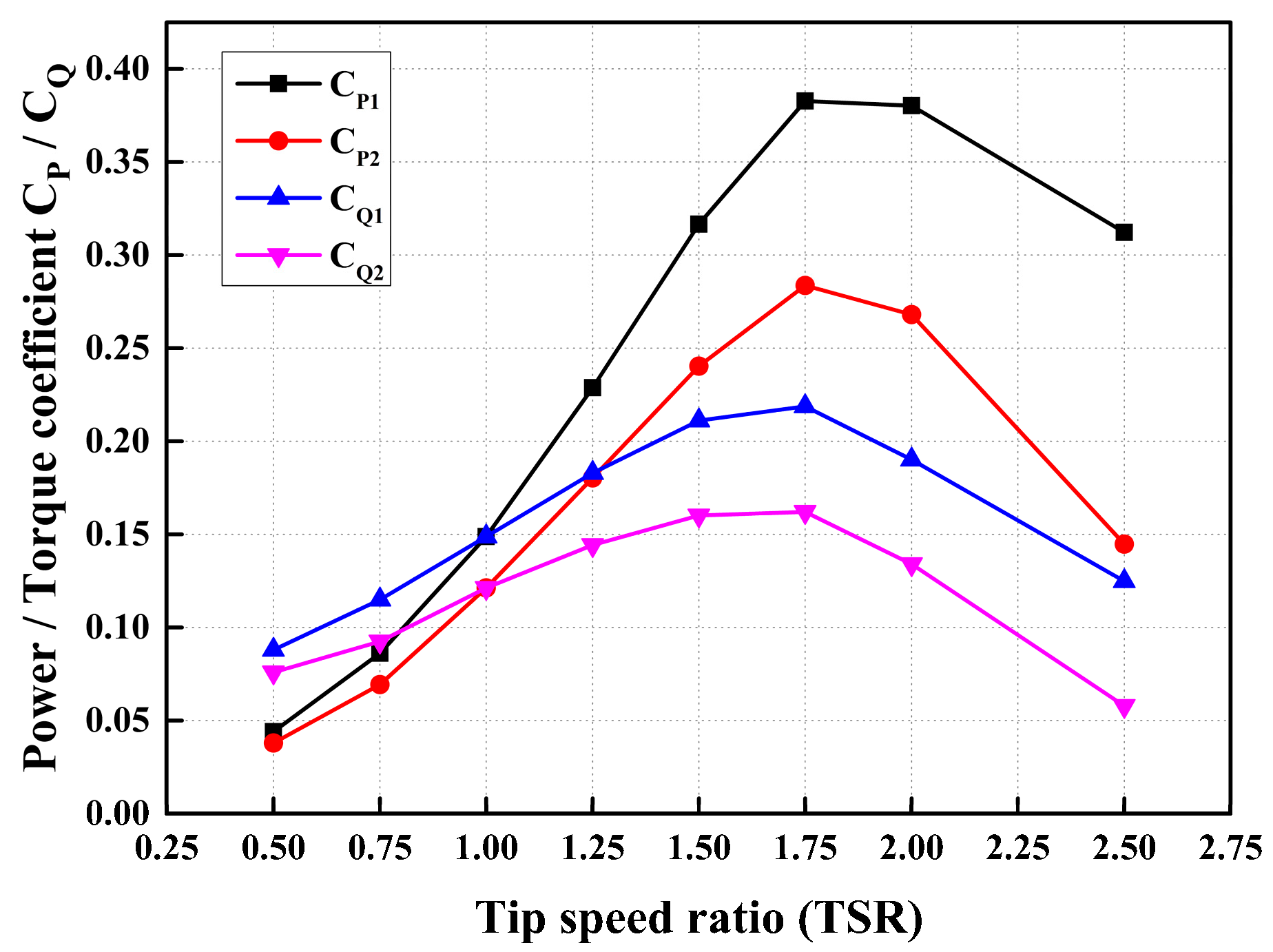
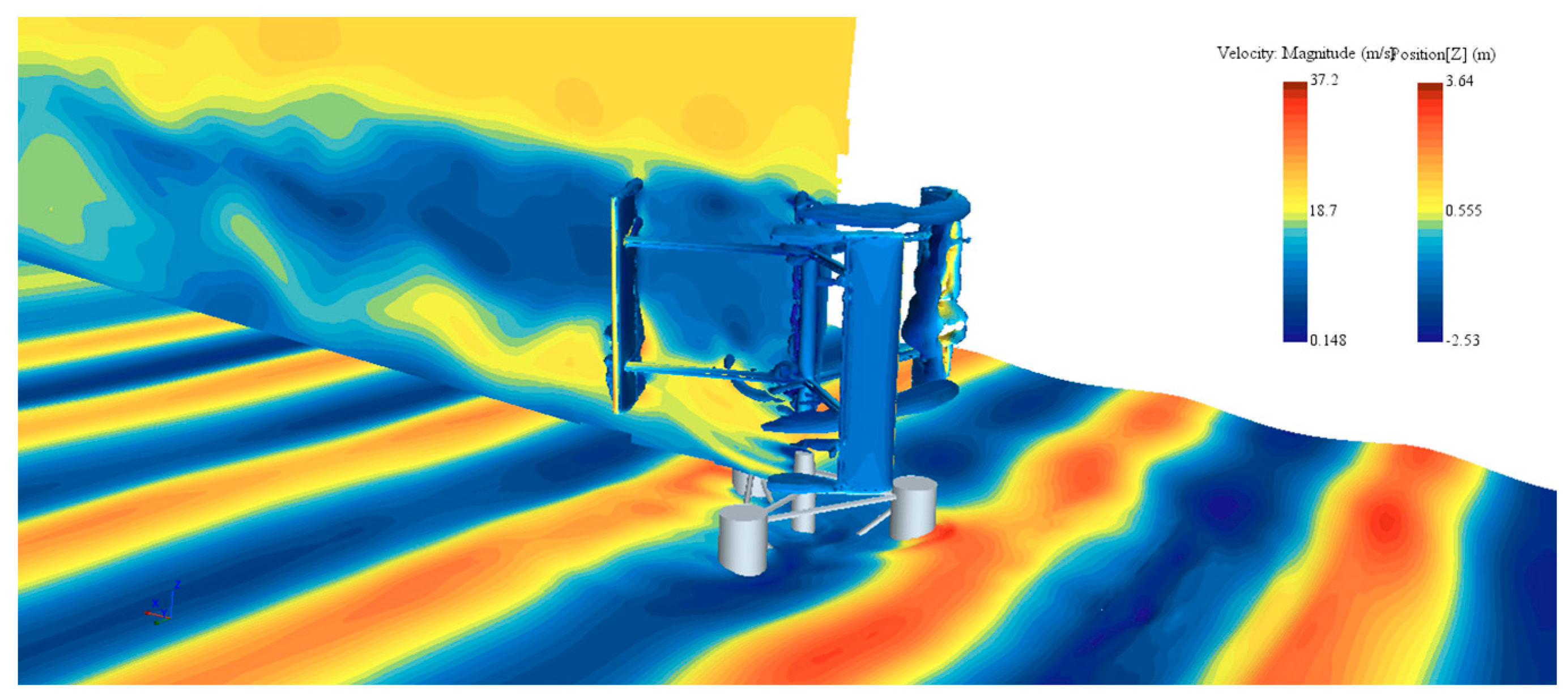
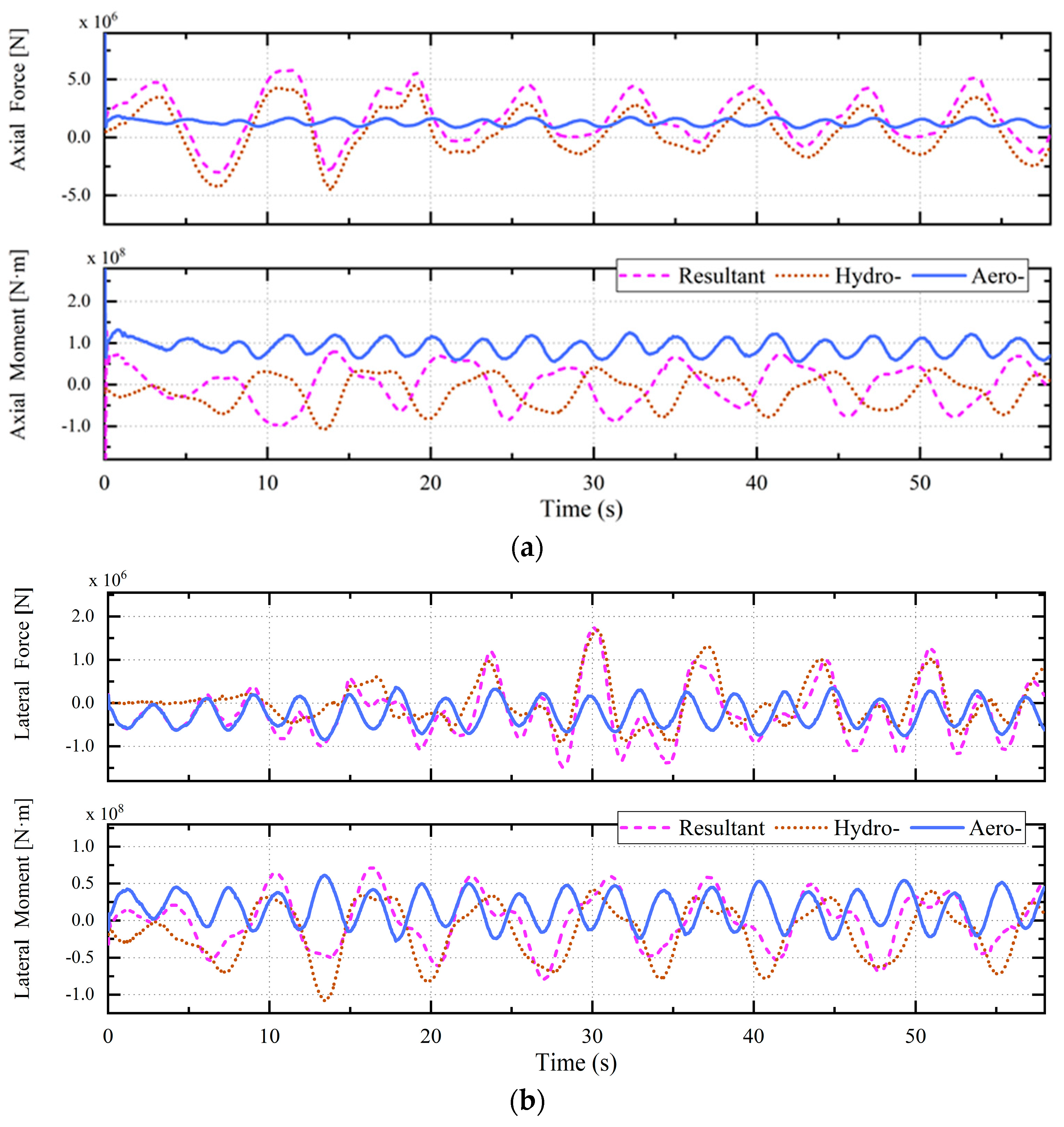

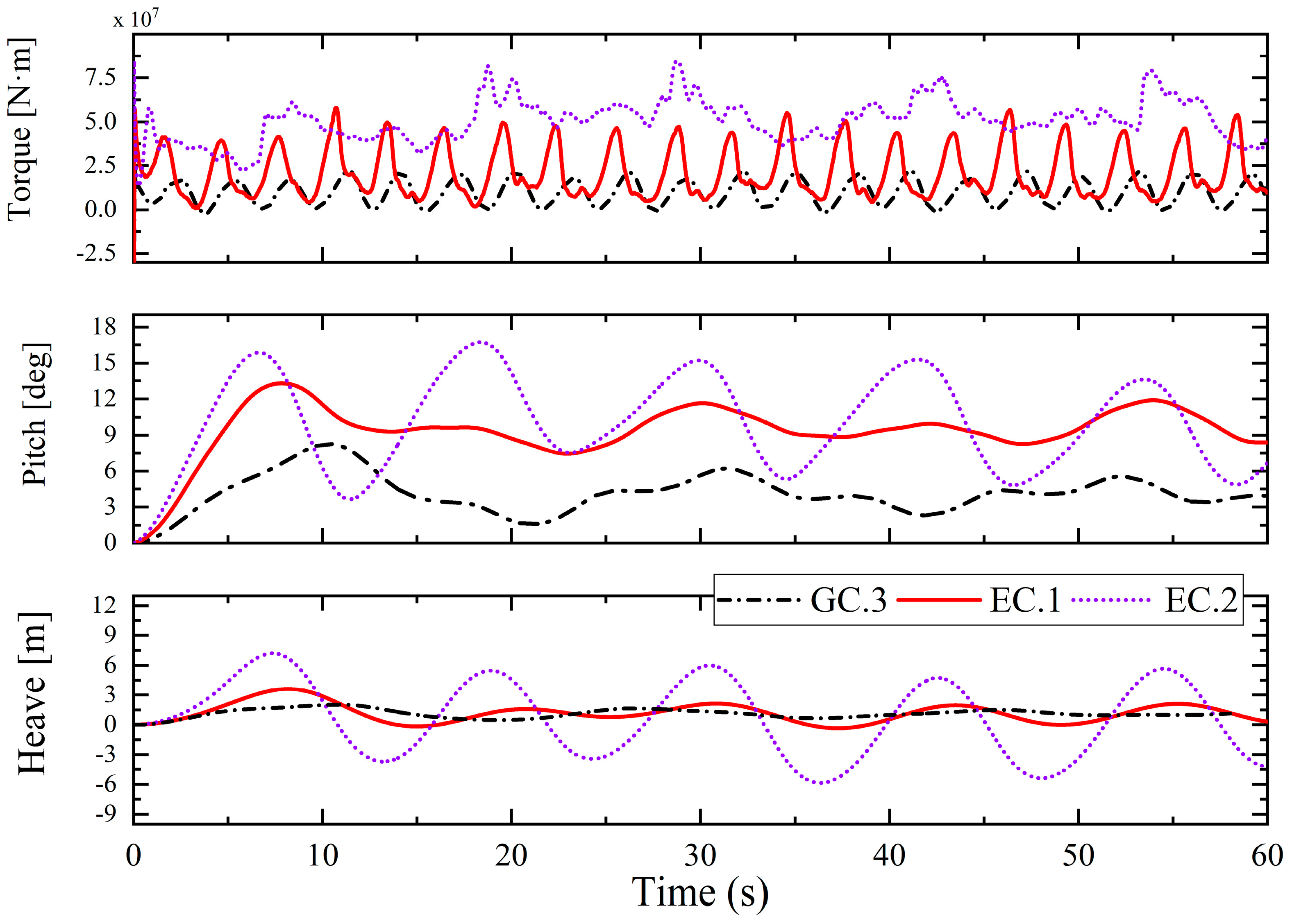

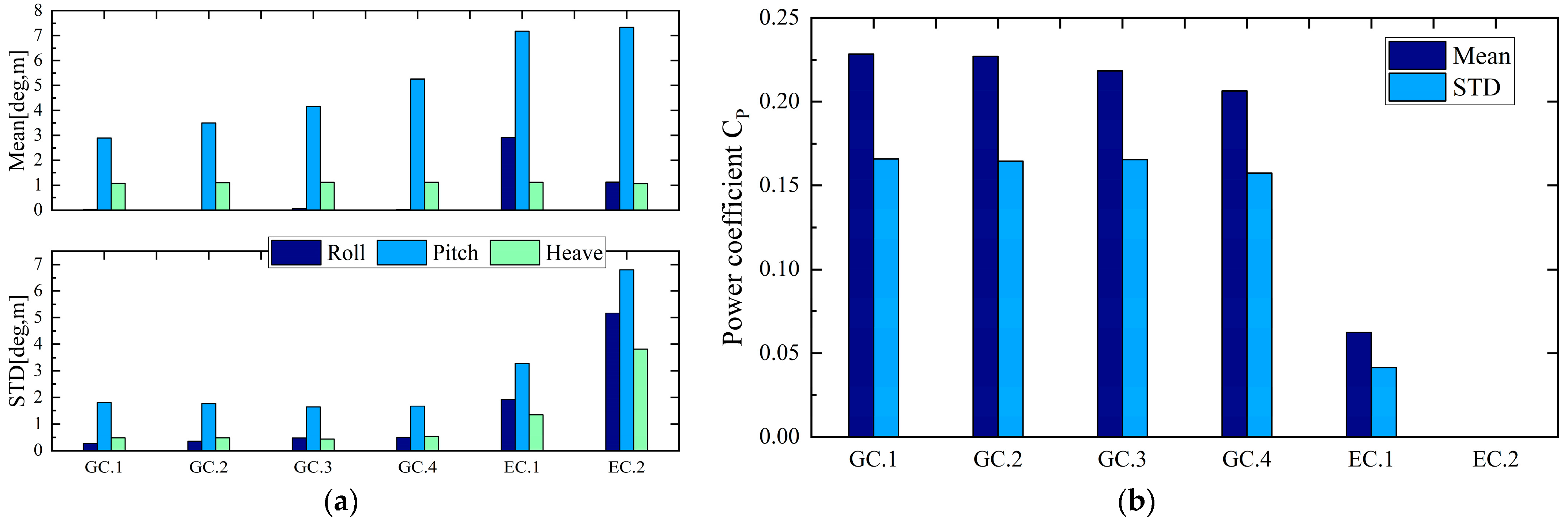
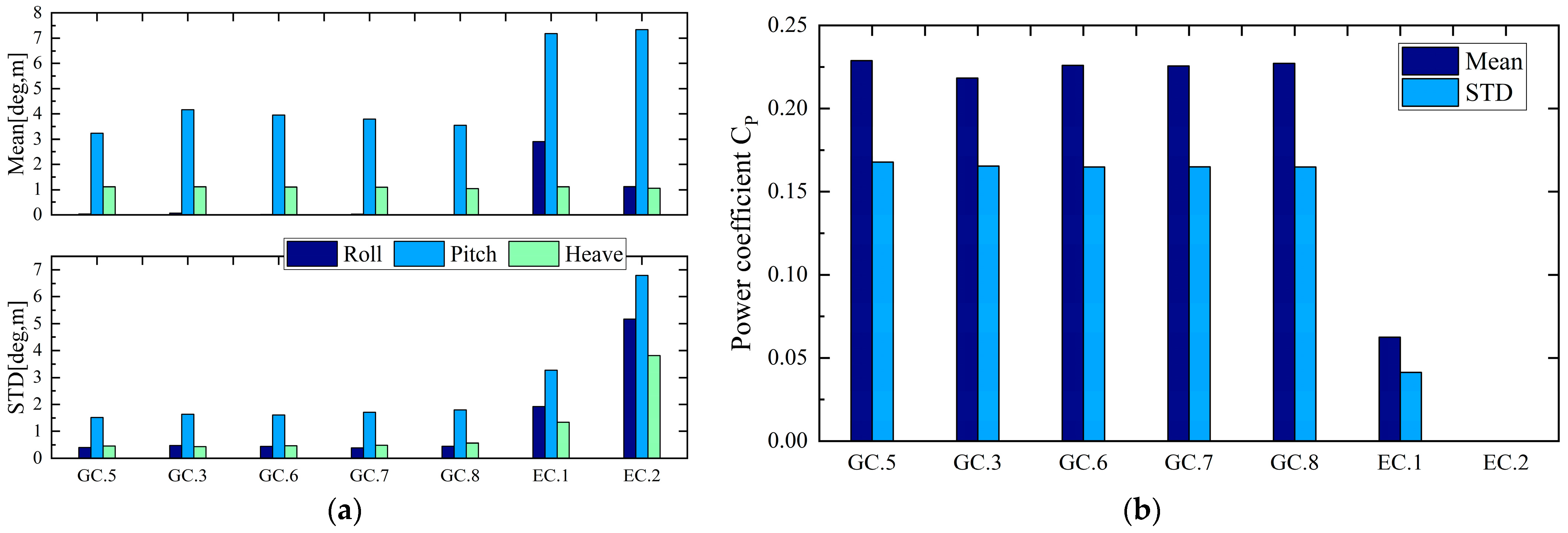

| Author (Year) | Rotor | Platform | Aerodynamic Module | Hydrodynamic Module |
|---|---|---|---|---|
| Wu et al. (2016) [11] | NERL-5MW | Spar-type | CFD | CFD |
| Tran and Kim (2018) [12] | NERL-5MW | DeepCWind | CFD | CFD |
| Wang et al. (2018) [13] | NERL-5MW | Spar-type | BEM | Potential flow |
| Zhang and Kim (2018) [14] | NERL-5MW | DeepCWind | CFD | CFD |
| Guo et al. (2019) [15] | Φ-type | Spar-type | Streamtube | Potential flow |
| Cheng et al. (2019) [16] | NERL-5MW | DeepCWind | CFD | CFD |
| Li et al. (2020) [17] | NERL-5MW | DeepCWind | BEM | Potential flow |
| Gao et al. (2022) [18] | Darrieus-type | TLP-type | Vortex | Potential flow |
| Lee et al. (2022) [19] | Darrieus-type | TLP-type | Streamtube | Potential flow |
| DOF | Exp [27] | Simo/Riflex [29] | Fast V8.1 [28] | Unsteady CFD [30] | naoe-FOAM-SJTU [16] | Present |
|---|---|---|---|---|---|---|
| Pitch | 26.8 | 25.8 | 25.0 | 25.2 | 25.8 | 25.6 |
| Roll | 26.9 | 26.0 | 25.0 | 25.3 | - | 25.7 |
| Heave | 17.5 | 17.1 | 17.7 | 17.8 | 17.58 | 17.7 |
| Property | Parameter |
|---|---|
| Mass | 1.37 × 107 kg |
| CM location below SWL | 12.53 m |
| Total structure roll inertia bout CM | 8.6 ×109 kg × m2 |
| Total structure pitch inertia bout CM | 8.6 ×109 kg × m2 |
| Total structure yaw inertia bout CM | 1.226 × 1010 kg × m2 |
| Property | Parameter |
|---|---|
| Aerofoil section | NACA0021 |
| Number of blades(n) | 3 |
| Length of chord(c) | 13.25 m |
| Rotor diameter(D) | 100 m |
| Height of straight-bladed(H) | 60 m |
| Pitching angle(β) | 8 deg |
| Height of center above main column | 48 m |
| Property | Parameter |
|---|---|
| Depth of platform base below SWL (total draft) | 20 m |
| Elevation to platform top (tower base) above SWL | 10 m |
| Distance between offset columns | 50 m |
| Height of upper columns | 26 m |
| Height of base columns | 6 m |
| Diameter of main column | 6.5 m |
| Diameter of offset (upper) column | 12 m |
| Diameter of offset (bottom) column | 24 m |
| Diameter of braces | 1.6 m |
| Case | H (m) | λ/L | V∞ (m/s) |
|---|---|---|---|
| GC.1 | 2 | 1 | 20 |
| GC.2 | 4 | 1 | 20 |
| GC.3 | 6 | 1 | 20 |
| GC.4 | 10 | 1 | 20 |
| GC.5 | 6 | 0.75 | 20 |
| GC.6 | 6 | 1.25 | 20 |
| GC.7 | 6 | 1.5 | 20 |
| GC.8 | 6 | 2 | 20 |
| GC.9 | 6 | 1 | 10 |
| GC.10 | 6 | 1 | 15 |
| GC.11 | 6 | 1 | 30 |
| EC.1 | 7.5 | - | 40 |
| EC.2 (parked) | 14 | - | 60 |
Disclaimer/Publisher’s Note: The statements, opinions and data contained in all publications are solely those of the individual author(s) and contributor(s) and not of MDPI and/or the editor(s). MDPI and/or the editor(s) disclaim responsibility for any injury to people or property resulting from any ideas, methods, instructions or products referred to in the content. |
© 2023 by the authors. Licensee MDPI, Basel, Switzerland. This article is an open access article distributed under the terms and conditions of the Creative Commons Attribution (CC BY) license (https://creativecommons.org/licenses/by/4.0/).
Share and Cite
Luo, W.; Liu, W.; Yang, M.; Chen, S.; Song, X.; Wu, W. Load Characteristics and Extreme Response of Straight-Bladed Floating VAWT Using a Fully Coupled Model. J. Mar. Sci. Eng. 2023, 11, 185. https://doi.org/10.3390/jmse11010185
Luo W, Liu W, Yang M, Chen S, Song X, Wu W. Load Characteristics and Extreme Response of Straight-Bladed Floating VAWT Using a Fully Coupled Model. Journal of Marine Science and Engineering. 2023; 11(1):185. https://doi.org/10.3390/jmse11010185
Chicago/Turabian StyleLuo, Wenping, Weiqin Liu, Meng Yang, Shuo Chen, Xuemin Song, and Weiguo Wu. 2023. "Load Characteristics and Extreme Response of Straight-Bladed Floating VAWT Using a Fully Coupled Model" Journal of Marine Science and Engineering 11, no. 1: 185. https://doi.org/10.3390/jmse11010185
APA StyleLuo, W., Liu, W., Yang, M., Chen, S., Song, X., & Wu, W. (2023). Load Characteristics and Extreme Response of Straight-Bladed Floating VAWT Using a Fully Coupled Model. Journal of Marine Science and Engineering, 11(1), 185. https://doi.org/10.3390/jmse11010185








